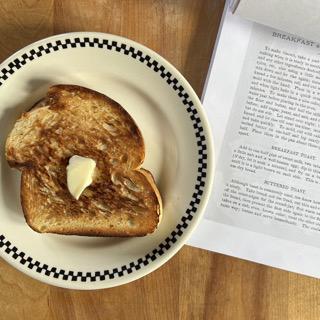The Erie Cook Book Revisited: Breaking Toast
Local home cook reheats historic recipes
Mrs. Laura Sterrett, author of 1881's The Erie Cook Book, opened up her collection of recipes with this passage: "A belief that I have collected, from various reliable sources, enough that is new and useful to justify the undertaking, is my excuse for issuing The Erie Cook Book." As such is my personal belief, I sense that Sterrett and I share the same gritty and practical visionary spirit it takes to produce a cookbook.
As a consumer science and physical recipe enthusiast, I plan to cook my way through The Erie Cook Book, cover to cover, and record notes on what works and what doesn't, hoping to improve upon the recipes and practices set out by Sterrett and her friends. I aim to ensure the recipes put forth are reliable and kitchen-tested by updating the concepts, language and ingredients when necessary.
To revise these recipes is to reflect upon history — family customs, entertaining trends, and food tastes have changed in the past 150 years, but the sense behind them is still applicable to the cooking sense of today. This goes for heritage and vintage cookbooks in general. Through the lens of old Erie, I want to take on the role of teacher as a civic responsibility and find out what people don't know about cooking and why.
Recipe: Buttered Toast
By: Laura Sterrett
"Although toast is commonly used, few know how to prepare it nicely. Take bread, not too fresh, cut thin and evenly, trim off the crust edges for the crumb-jar; first warm each side of the bread, then present the first side again to the fire until it takes on a rich, even, brown color; treat the other side in the [same] way; butter and serve immediately. The coals should be bright and hot. Toast properly made is very digestible, because the moisture is extracted and the bread has become pure farina of wheat, but when it is exposed to a hot fire and the outside charred, the inside remains as moist as ever. Butter applied to it while warm does not penetrate, but floats on the surface in the form of rancid oil. Or, beat one cup of butter and three tablespoons of flour to a cream, pour over this one and a half pints boiling water; place over a kettle of boiling water for ten minutes, dip into it the toast, and serve hot. Or dip each slice of toast in boiling hot water (slightly salted) spread with butter, cover, and keep hot."
Toast has always been one of my favorite foods: contrasting crisp and soft textures, a vehicle for butter, and appropriate anytime of the day or night. Flashy toasters and toaster ovens made toast popular for the aforementioned reasons, but also because it can be eaten "on the go." No wonder I have had blinders on cooking toast on a skillet my whole life! These devices have pulled me away from what real toast actually is: drawing the moisture from the exterior of a piece of bread and crisping it evenly. Prior to the invention of the toaster, there were particular methods for cooking toast for breakfast, methods that warranted Sterrett to publish a 22-line recipe on the subject. Below, I've regarded her methods, but built upon them:
Stovetop Toast
By: Morgan Yezzi
Begin by heating cast iron (I use a Griswold #9 skillet) or any heavy skillet on the stovetop at medium heat. Evenly slice a piece of bread and place it on the warming pan. As the moisture begins to release, the bread will elicit a slight hiss. After 2-3 minutes, flip the bread over and let it brown on the other side. Continue flipping the piece of toast until it reaches your desired darkness. Butter the hot bread and serve immediately with preserves.
To Revive Stale Toast
2 cups water, salted
1-2 slices stale bread
Butter and preserves for serving and spreading
If you find yourself with bread that has become stale, it can be revived with moisture.
Boil 2 cups of salted water.
Using tongs, dunk the stale bread into the water and then pass it over to a plate.
Spread the bread with soft butter and cover with a lid.
Serve with baked eggs over a bed of sautéed greens, albumen grapefruit, and hot coffee.
Sterrett presents a "cream toast." I found it to be quite cumbersome, cakey, and flavorless — this is coming from someone who can make a soufflé for four, moments after rolling out bed. I updated it to be a more flavorful bread confection: custard toast, which is bread that is soaked in a custard mix until its fully absorbed, browned on all sides, and served with fruit.
Custard Toast for Two
2 2-inch thick pieces of bread
1 cup of milk
1/4 cup freshly squeezed orange juice
2 eggs, beaten
1/2 teaspoon salt
1/2 teaspoon vanilla
1. Whisk all of the ingredients in a loaf pan.
2. Set the bread into the custard mixture and let it absorb for 10 minutes. Flip the bread after 5 minutes and push down onto it gently to help the bread absorb the custard.
3. Heat a pan on the stovetop and melt 1 tablespoon of butter. Just as the butter stops bubbling, place the sopping bread into the pan. Cook on all sides until golden brown.


.png)
